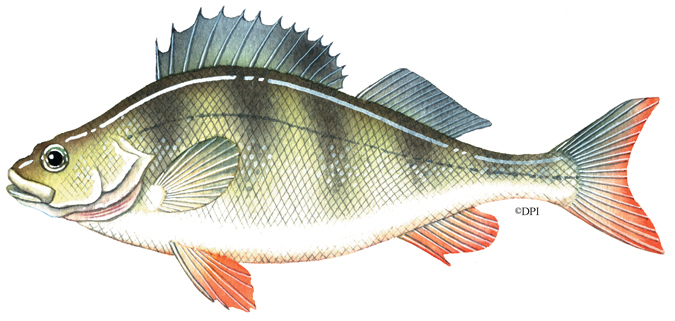English perch

| Common Name: | English perch |
| Other Name/s: | European perch, Redfin perch, Redfin |
| Family: | Percidae |
| Scientific Name: | Perca fluviatilis (Linnaeus, 1758) |
| Origin: | Introduced |
| The classification of "introduced" reflects its translocation to Australia and Victoria, and this category is noted in the Flora and Fauna Guarantee Act 1988 (introduced to Australia after 1788 AD). | |
Description
Deep body with a large head. Large mouth reaching back to below the eye. Large body scales. Two dorsal fins, but no adipose fin. Tail is slightly forked. Upper body usually grey to olive-green, greenish to silvery sides, white belly. Six or more vertical dark bands across the back and sides, more prominent in younger fish. Dorsal (top) and tail fins are grey to green with a distinct black blotch of the front dorsal fin. Other fins and lower tail fin are usually bright orange or red.
Distribution
Widespread and common in many Victorian lakes and streams. Distribution appears to be limited by an upper water temperature of about 31°C. Can be very abundant locally.
Habitat
Occurs in a wide variety of habitats, including lakes, dams, billabongs, swamps and the slower-flowing reaches of rivers and streams. Prefers areas with abundant weed, vegetation or other cover such as rocks and fallen timber. Does not occur in fast waters and is usually absent from high altitude areas.
Brief Biology
Known to reach 50 cm in length and 10 kg in weight in Australia, most fish in Victoria are smaller, rarely exceeding 2.5 kg. Redfin are usually 2-3 years old before reaching sexual maturity, but some individuals have been found to be reproductively mature at 12 months of age and 20 cm in length. A female fish can produce up to 200,000 eggs. It is not hard to see how they have successfully colonised nearly all suitable waters in Victoria. An attempt has been made to exclude them from waters in Gippsland and even now they are restricted to only a few localities. Please assist by not using them as bait or stocking them into waters or dams. Adult fish spend most of their time on the substrate and close to cover such as rocks, debris and weed beds in rivers, so these are good places to drop your line.
Spawning occurs at night in late winter and spring (mid August to late October) when water temperatures reach 12°C, in quiet areas away from fast currents and often amongst aquatic vegetation and debris. Hatching occurs 7-8 days later, with juvenile fish schooling for some time before becoming solitary.
Other Notes
Native to temperate areas of Europe. Introduced to Australia by fish acclimatisation societies via Tasmania (1862) and Victoria (1868). A popular angling species, with good flesh.
Competes for food and space with native and introduced angling species. Redfin have impacted on native fish stocks by competition, and smaller native fish species through predation.
Redfin breed readily in still waters and tend to over-populate smaller bodies of water resulting in large populations of stunted fish. Redfin are now known to carry a lethal virus which in certain conditions can be transferred to other introduced fish, such as trout, and to native fish. For this reason the transfer of live redfin is discouraged. Some native fish can also be affected at times.
They are carnivorous, taking a wide range of aquatic foods but the larger fish prefer yabbies and other fish. Baits are best presented on a running sinker or paternoster rig.
Redfin are also taken by spinning and trolling using a wide range of spinners and lures. Spinners with vibration and revolving flashing blades are always popular. Jigging (moving a special lure up and down in the water) close in around snags and submerged trees, can also be very productive. They can also be caught on wet flies.
Regulations
Recreational Fishing Licence requirements and regulations affecting the taking of English perch in Victoria are available in the Victorian Recreational Fishing Guide, available free from Recreational Fishing Licence sales agents and DEDJTR Offices and Information Centres.
Further Reading
- A Guide to the Freshwater Fish of Victoria, Phillip Cadwallader & Gary Backhouse, Department of Conservation and Environment.
- Australian Freshwater Fishes, John R. Merrick & Gunther E. Schmida.
- Salmon at the Antipodes, John Clements.

